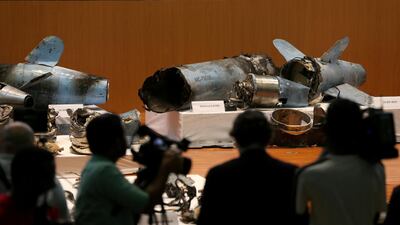The missile and drone attack on Saudi oil production on September 14 last year left Iran sensing it had received a return on the investment it had made in Yemen’s Houthis.
It happened after a series of explosions in oil tankers in the Gulf in May and June 2019 that Saudi Arabia and the US blamed on Tehran.
Iran’s economy and oil exports have been hit hard by intensified US sanctions since Washington withdrew from the nuclear deal in 2018 and Tehran had made it clear that US allies in the region would pay for supporting American policies.
Jordanian professor Hasan Al Momani told The National that the Abqaiq-Khurais attack demonstrated Iran's lack of interest in a solution to the conflict in Yemen because it "would neutralise an important Iranian card that makes Iran a difficult player to respond to".
“Iran’s influence stems from its sub-agents, whether in Syria, Lebanon, Iraq or Yemen. They give Iran ambiguity,” said Mr Momani, who teaches International Studies at the University of Jordan.
“Any settlement in any of these countries would rob Iran of its cards. It is only interested in a settlement advantageous to its proxies,” he said.
A report by UN officials monitoring sanctions on Yemen said in January that the Houthis did not carry out the attack on the Saudi oil plants. UN Secretary General Antonio Guterres also told the Security Council that some of the weapons used in the attack were of Iranian origin.
But the United Nations did not, as Washington and Riyadh did, blame the attack on Tehran.
Saudi Arabia responded to the attack through diplomatic means by demanding UN action.
The US sent more troops to the kingdom in October and started the Bahrain-based International Maritime Security Construct. Among the IMSC members are Saudi Arabia and the UAE, Australia and the United Kingdom. US commanders said reconnaissance was the main object of the IMSC and that the ships do not seek confrontation with Iran.
The US responded directly to Tehran by killing Iranian military supremo Qassem Suleimani in Baghdad in January. It was the first overt US response against an Iranian target since the 1980-1988 war between Iran and Iraq.
Veteran Lebanese political commentator Abdulwahab Badrakhan said that the three and half months that passed between the Aramco attack and the killing of Suleimani shows how difficult it is to respond to Tehran’s clandestine actions.
The Aramco strike was “for the Iranians to see how far they can test the Americans and then how far they can go,” he said.
“Iran’s message was that they will not remain silent as the Americans ramped up sanctions that hurt its oil sector and built a naval coalition in the Gulf,” Mr Badrakhan said by phone from London.
But he said Iran’s gains plateaued after the Aramco attack, pointing to the failure to ease restrictions on its oil exports and the failure of a French initiative that sought to bring about direct communication between Donald Trump and Hassan Rouhani during a UN meeting in New York in late September.
Mr Badrakhan said that even if presidential contender Joe Biden wins the US election in November it would be difficult to go back to the accommodation Iran received under Barack Obama.
“Biden will not be bearing gifts for Iran if he becomes president,” Mr Badrakhan said.


